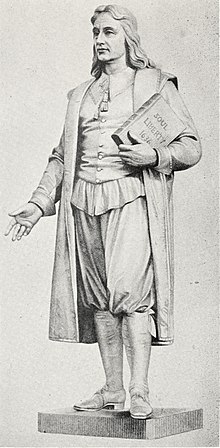By Paul Davis
The Department of Transportation has agreed to erect a plaque in Providence, but has yet to agree on how it will look or where it will go.
During a closed meeting, DOT officials talked about materials, size, design and location, but made no decisions, said DOT spokeswoman Dana Alexander Nolfe.
Native American Julianne Jennings suggested the plaque a year ago.
The public marker will be the first in the region dedicated to “an almost forgotten piece of New England history,” said Jennings, a former Rhode Island College professor now studying at the School of Human Evolution & Social Change in Tempe, Ariz.
In 1636, Narragansett Indian Sachem Canonicus and his people gave Roger Williams the land that later became the Rhode Island colony, according to Jennings’ wording for the plaque.
But, in just 40 years, “relations between the colony and the Narragansett Indians became strained as a result of frequent intercultural conflicts,” the text says.
Those conflicts erupted into the bloody King Philip’s War, which raged for several years during the 1670s.
After the fighting was over, Roger Williams and other Colonists held a town meeting on Aug. 14, 1676, Jennings said.
The town was full of Indian prisoners, and “slavery was regarded a fit punishment” for their crimes, Jennings said. They were sent to the Caribbean, Portugal, Spain and Africa, where they were sold as slaves.
Roger Williams (theologian)
Indian language and culture
Williams intended to become a missionary to the Native Americans and set out to learn their language. He studied their language, customs, religion, family life and other aspects of their world. As a result he came to see their point of view about colonization and developed a deep appreciation of them as people. He wrote his A Key into the Language of America (1643) as a kind of phrase book coupled with observations about life and culture as an aid in communication with the Indians. In it he talked about everything from salutations in the first chapter to death and burial in chapter 32. The book also sought to instruct the English, who thought of themselves as vastly superior to the Native Americans, that they were mistaken. He repeatedly made the point that the Indians were just as good as the English, even superior in some respects.
"Boast not proud English, of thy birth & blood;
Thy brother Indian is by birth as Good.
Of one blood God made Him, and Thee and All,
As wise, as fair, as strong, as personal."
Having learned their language and customs, Williams gave up the idea of being a missionary and never baptized a single Indian. He was severely criticized by the Puritans for failing to Christianize them, but Williams had arrived at the place in his own thinking that no valid church existed. He said he could have baptized the whole country, but it would have been hypocritical and false. He formed firm friendships and developed deep trust among the Native Americans, especially the Narragansetts. He was able to keep the peace between the Indians and English in Rhode Island for nearly forty years because of his constant mediation and negotiation. He twice surrendered himself as a hostage to the Indians to guarantee the safe return of a great sachem from a summons to a court: Pessicus in 1645 and Metacomet (King Philip) in 1671. He more than any other Englishman was trusted by the Native Americans and proved to be trustworthy. In the end King Philip’s War (1675–1676) was one of the bitterest events in his life as his efforts ended with the burning of Providence in March 1676, including his own house.
Julianne Jennings is a friend who's appeared in this blog before. She led the protests against the King Philip's War game last year.
For more on King Philip, see King Philip Chainsaw Sculpture and King Philip's War in After the Mayflower.
Below: Roger Williams statue by Franklin Simmons.


6 comments:
To remember Roger Williams as a slave trader is vicious and unclean. I commend those who oppose this false plaque as utterly inconsistent with that for which Roger Williams fought throughout his life. It must be a work of misguided hatred. Many thanks for this article and all best wishes.
"Vicious and unclean"? Those are rather ridiculous moral judgments. They have no place in a debate like this.
The main thing that matters is whether the claim is true or not. I don't think anyone has disproved the claim that Williams sold Indians into slavery. Therefore, we should acknowledge it even if Williams fans don't like it.
Why must we erect a plaque to highlight this? Many other prominent figures in history took place in the slave trade. Should we erect plaques for them too? It seems pointless to me. It was a common practice of the time period. It wasn't seen as wrong then. We learned out lesson, there's no point in living in the past, as long as we don't forget it, which we don't need a plaque to do.
The fact that some people (like Anonymous #1) think Williams is a saint is reason enough for the plaque. As with Washington, Jefferson, and every other slaveowner, we should know the whole story. Most of the time we lionize these people, so it's good to set the record straight.
The Emancipation Proclamation was drafted (by Thomas Jefferson) before the Constitution was signed...
Slavery was certainly seen as wrong then, at least by the slaves! Also by Quakers and other abolitionists
Post a Comment